These TS 10th Class Biology Bits with Answers 4th Lesson Excretion will help students to enhance their time management skills.
TS 10th Class Biology Bits 4th Lesson Excretion
Choose the correct answer.
Question 1.
The alkaloid used as medicine for snake bite is ……..
A) Reserpine
B) Quinine
C) Coffeine
D) Scopolamine
Answer:
A) Reserpine
Question 2.
Identify the animal in which excretory organ is absent.
A) Bird
B) Amoeba
C) Sponge
D) B and C
Answer:
D) B and C
![]()
Question 3.
Incorrect pair in the following
A) Platyhelminthes – Flame cells
B) Arthropoda – Malpighian tubules
C) Mollusca – Metanephridia
D) Protozoa – Water vascular system
Answer:
D) Protozoa – Water vascular system
Question 4.
Urine formation mechanism have the following 4 steps. Arrange them systematically.
I) Tubular reabsorption
II) Glomerular filtration
III) Concentration of urine
IV) Tubular secretion
(OR)
The stages of urine formation in sequential order.
A) (i). (ii), (iii), (iv)
B) (iv), (iii), (ii), (i)
C) (iii), (ii), (i), (iv)
D) (ii), (i), (iv), (iii)
Answer:
D) (ii), (i), (iv), (iii)
Question 5.
Choose the correct pair.
A) Protozoa – Flame cells
B) Annelida – Kidneys
C) Echinodermata – Nephridia
D) Arthropoda – Green glands
Answer:
D) Arthropoda – Green glands
![]()
Question 6.
Excretory organ in phylum Platy helminthes.
A) Nephridia
B) Flame cells
C) Green glands
D) Kidneys
Answer:
D) Kidneys
Question 7.
Identify the wrong sentence.
A) Taking a protein rich diet will result in more formation of Uric acid in urine.
B) Sugar appears in urine of a diabetic person.
C) Urine has amber colour due to presence of Urochrome.
D) A large intake of liquids or water increases the volume of water, hence more urine is excreted.
Answer:
A) Taking a protein rich diet will result in more formation of Uric acid in urine.
Question 8.
The most poisonous of all waste products of metabolism is ………
A) urea
B) uric acid
C) ammonia
D) biliverdin
Answer:
C) ammonia
![]()
Question 9.
Dark coloured outer zone of the kidney is called ………
A) Cortex
B) Medulla
C) Pyramid
D) Calyces
Answer:
A) Cortex
Question 10.
The kidneys ………..
A) Regulate blood volume
B) Control blood pressure
C) Control pH
D) All of the above
Answer:
D) All of the above
Question 11.
All of the following belong to the urinary system except ……………..
A) urethra
B) ureter
C) bladder
D) prostrate
Answer:
D) prostrate
Question 12.
Most glucose molecules are reabsorbed in the ……………
A) Proximal convoluted tubule
B) Distal convoluted tubule
C) Collecting ducts
D) Loop of Henle
Answer:
A) Proximal convoluted tubule
![]()
Question 13.
Which of the following substances can be eliminated from blood by tubular secretions ?
A) potassium ions
B) hydrogen ions
C) ammonium Ions
D) all the above
Answer:
D) all the above
Question 14.
Which of the following is correct?
A) Quinine — Pain killer
B) Scopolamine — Medicine for snake bite
C) Nicotine — Antiseptic
D) Morphine — Pain killer
Answer:
D) Morphine — Pain killer
Question 15.
Arrange the following parts in sequential order.
i) Collecting tube
ii) Pyramids
iii) DCT
iv) Ureters
v) Pelvis
vi) Calyces
A) iii,i, ii, vi, v, iv
B) i,ii, iii, iv, vi, v
C) iii,i, ii, v, iv, vi
D) v, iv, vi, i,ii, iii
Answer:
B) i,ii, iii, iv, vi, v
![]()
Question 16.
All the following are principle solutes of urine except [ ]
A) urea
B) creatinine
C) glycogen
D) uric acid
Answer:
C) glycogen
Question 17.
Which of the following hormones increase reabsorption in the collecting ducts?
A) Renin
B) Vasopressin
C) Aldosterone
D) Insulin
Answer:
B) Vasopressin
Question 18.
The primary function of the ascending loop of Henle in the kidney [ ]
A) The active reabsorption of sodium
B) The active reabsorption of chloride ions
C) The passive reabsorption of potassium
D) The passive reabsorption of urea
Answer:
A) The active reabsorption of sodium
Question 19.
What might be the reason for renal vein carries, pure deoxygenated blood? [ ]
A) filtering of waste material
B) deoxygenated blood enter through renal artery
C) during process of filtration oxygen is utilised
D) due to presence of more glucose
Answer:
C) during process of filtration oxygen is utilised
Question 20.
Which of the following would fend to Increase urine production? [ ]
A) Increased activity levels
B) Increased body temperature
C) Decreased water consumption
D) Increased water consumption
Answer:
C) Decreased water consumption
![]()
Question 21.
Bowman’s capsule is lined by a single layer of squamous epithelial cells called [ ]
A) Raphides
B) Podocytes
C) Erythrocytes
D) Dopocytes
Answer:
B) Podocytes
Question 22.
Mechanism of urine formation involves ………….
A) Glomerular filtration and Tubular reabsorption
B) Tubular secretion
C) Concentration of urine
D) All the above
Answer:
D) All the above
Question 23.
What term is used to describe the fluid In the renal tubules? [ ]
A) filtrate
B) solvent
C) plasma
D) urine
Answer:
A) filtrate
Question 24.
The process responsible for urine production that takes place in the nephron are ……………..
A) Secretion and digestion
B) Reabsorption and selection
C) Ultrafiltration and selective reabsorption
D) Filtration and peristalsis
Answer:
C) Ultrafiltration and selective reabsorption
Question 25.
Glomerulus develops from …………….
A) Afferent arteriole
B) Efferent arteriole
C) Renal artery
D) Renal vein
Answer:
A) Afferent arteriole
Question 26.
Primary urine is equal to blood in chemical composition except the presence of …………….
A) Blood cells
B) Plasma
C) Water
D) Urea
Answer:
A) Blood cells
![]()
Question 27.
The part of the renal tubule that maintains a proper concentration and pH of the urine ……………
A) Proximal convoluted tubule
B) Loop of Henle
C) Distal convoluted tubule
D) Collecting duct
Answer:
C) Distal convoluted tubule
Question 28.
Ultra filtration of blood occurs in ………….
A) Glomerulus II
B) Pelvis
C) Proximal convoluted tubule
D) Loop of henle
Answer:
A) Glomerulus II
Question 29.
Tubular secretion ensures removal of all the waste products from blood like [ ]
A) urea, uric acid
B) creatinine
C) salt ions like K+, Na+ and H+ ions
D) all the above
Answer:
D) all the above
![]()
Question 30.
Concentration of urine in the collecting tubes takes place in the presence of [ ]
A) Vasopressin
B) Insulin
C) Aldosterone
D) Adrenaline
Answer:
A) Vasopressin
Question 31.
The storage capacity of urinary bladder is [ ]
A) 300 – 700ml
B) 300 – 800ml
C) 400 – 700 ml
D) 300 – 600 ml
Answer:
B) 300 – 800ml
Question 32.
Total amount of urine excreted per day is about [ ]
A) 1.5 to 1.7 litres
B) 1.6 to 1.8 litres
C) 1.4 to 1.6 litres
D) 1.3 to 1.5 litres
Answer:
B) 1.6 to 1.8 litres
Question 33.
In dialyzing fluid these substances are absent. [ ]
A) Nitrogenous wastes
B) Salts
C) Proteins
D) Sugars
Answer:
A) Nitrogenous wastes
Question 34.
First kidney transplantation was performed by a scientist [ ]
A) William Harvey
B) Charles Hufnagel
C) Robert Peterson
D) Norman Borlag
Answer:
B) Charles Hufnagel
Question 35.
The excretory organ that removes carbon dioxide and water is [ ]
A) Kidney
B) Skin
C) Lung
D) Liver
Answer:
C) Lung
![]()
Question 36.
Skin sends out wastes like [ ]
A) water
B) salts
C) urea
D) water and salts
Answer:
D) water and salts
Question 37.
The sebaceous glands In the skin excrete [ ]
A) Waxes, sterols
B) Sterols, carbohydrates
C) Waxes, fatty acids
D) Waxes, sterols, hydro carbons and fatty acids
Answer:
D) Waxes, sterols, hydro carbons and fatty acids
Question 38.
These are the metabolic wastes of haemoglobin of dead red blood cells
A) Bilirubin, biliverdin and urochrome
B) Urea, uric acid
C) Water, mineral salts
D) Bilirubin, water
Answer:
A) Bilirubin, biliverdin and urochrome
Question 39.
Excess salts of these elements are excreted by colon of large intestine.
A) calcium
B) calcium, magnesium
C) magnesium, iron
D) calcium, magnesium and iron
Answer:
D) calcium, magnesium and iron
![]()
Question 40.
The organism that remove waste products by simple diffusion is [ ]
A) Earthworm
B) Amoeba
C) Starfish
D) Planaria
Answer:
B) Amoeba
Question 41.
Flame cells are excretory organs in [ ]
A) Annelids, Arthropods
B) Platyhelminthes and Nematoda
C) Mollusca
D) Echinodermata
Answer:
B) Platyhelminthes and Nematoda
Question 42.
Identify the ‘X’ and ‘Y’ in the given diagram.
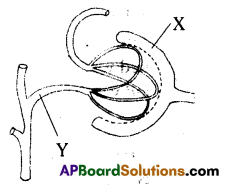
A) PCT and Bowman’s eapsule
B) Bowman’s capsule and efferent arteriole
C) Bowman’s capsule and afferent arteriole
D) Glomerulus and efferent arteriole
Answer:
C) Bowman’s capsule and afferent arteriole
Question 43.
In Annelids this is the excretory organ. [ ]
A) Meta nephridia
B) Nephridia
C) Green glands
D) Malphigian tubules
Answer:
B) Nephridia
![]()
Question 44.
In starfish excretory system is [ ]
A) Canal system
B) Malphigian tubules
C) Water vascular system
D) Green glands
Answer:
C) Water vascular system
Question 45.
In plants waste products are stored in [ ]
A) Leaves, bark
B) Bark, fruits
C) Leaves, fruits
D) Leaves, bark and fruits
Answer:
D) Leaves, bark and fruits
Question 46.
Identify the primary metabolite. [ ]
A) Fats
B) Gums
C) Latex
D) Tannins
Answer:
A) Fats
Question 47.
Alkaloids are the by products [ ]
A) Carbon
B) Oxygen
C) Nitrogen
D) Phosphorous
Answer:
C) Nitrogen
Question 48.
Identify the stimulant of central nervous system. [ ]
A) Reserpine
B) Caffeine
C) Nimbin
D) Quinine
Answer:
B) Caffeine
Question 49.
Antiseptic Nimbin is obtained from these parts of neem tree [ ]
A) Seeds
B) Barks
C) Leaves
D) All the above
Answer:
D) All the above
Question 50.
Gums are used as adhesives and bindingagents in the preparation of
A) Food
B) Paints
C) Varnishes
D) Food and medicines
Answer:
D) Food and medicines
Question 51.
The Latex of Heavea braziliensis gives
A) Plastic
B) Resin
C) Rubber
D) Gum
Answer:
C) Rubber
![]()
Question 52.
Pollen grains cause allergy due to the presence of [ ]
A) Carbon substances
B) Nitrogenous substances
C) Sulphur substances
D) All the above
Answer:
B) Nitrogenous substances
Question 53.
The endocrine gland presents on kidney is [ ]
A) Thyroid
B) Pancreas
C) Adrenal gland
D) Pituitary gland
Answer:
C) Adrenal gland
Question 54.
Diabetes insipidus is due to the deficiency of hormone [ ]
A) Insulin
B) Vasopressin
C) Adrenaline
D) Paratharmone
Answer:
B) Vasopressin
Question 55.
Excretory organs in Arthropodas [ ]
A) Flame cells
B) Green glands
C) Maiphigian tubules
D) Green glands, Maiphigian tubules
Answer:
D) Green glands, Maiphigian tubules
Question 56.
What will happen if one kidney of a person is removed? [ ]
A) He will survive and remain normal
B) He will die
C) Urea will go on accumulating in the blood
D) Urination will stop
Answer:
A) He will survive and remain normal
Question 57.
A cluster of capillaries in the kidney [ ]
A) Glomerulus
B) Pyramids
C) Calyces
D) Ureter
Answer:
A) Glomerulus
![]()
Question 58.
Identify the correct sentence given below. [ ]
A) Right kidney — slightly lower than left kidney
B) Right kidney — slightly higher than left kidney
C) Right kidney — left kidney are same height
D) Right kidney — is nearer to vertebral column than left kidney
Answer:
A) Right kidney — slightly lower than left kidney
Question 59.
Morphine, Cocaine are extracted from this part ofPapaverSomniferum
A Bark
B) Fruit
C) Root
D) Seed
Answer:
B) Fruit
Question 60.
Antimalarial drug quinine is manufactured from the bark of [ ]
A) Rauwolfia serpentina
B) Azadirachta indica
C) Cinchona officinalis
D) Nicotiana tobacum
Answer:
C) Cinchona officinalis
Question 61.
Nicotine is prepared from this part of Nicotiana tobacum
A) Leaves
B) Bark
C) Root
D) Seed
Answer:
A) Leaves
Question 62.
Nim bin is an antiseptic, extracted from the seeds, barks, leaves off [ ]
A) Cinchona officinalis
B) Papayer somniferum
C) Azadirachta Indica
D) Chrysanthemum
Answer:
C) Azadirachta Indica
Question 63.
Insecticide pyrethroids are extracted from which part of chrysanthemum [ ]
A) Seed
B) Root
C) Fruit
D) Flower
Answer:
D) Flower
![]()
Question 64.
From the fruit and flower of Daturastramonium the sedative extracted is [ ]
A) Nimbin
B) Scopolamine
C) Pyrethroids
D) Reserpine
Answer:
B) Scopolamine
Question 65.
Water bathes all most all their cells In these phyla of animals [ ]
A) Platyhelmenthes and nematoda
B) Porifera and coelenterata
C) Arthropoda, Mollusca
D) Mollusca, Echinodermata
Answer:
B) Porifera and coelenterata
Question 66.
Green glands and Maiphigian tubules are excretory organs [ ]
A) Annelids
B) Arthropoda
C) Mollusca
D) Echinodermata
Answer:
B) Arthropoda
Question 67.
In mollusca excretory organs are [ ]
A) Nephridia
B) Water vascular system
C) Metanephridia
D) Kidneys
Answer:
C) Metanephridia
Question 68.
Water vascular system is excretory system in [ ]
A) Echinodermata
B) Moilusca
C) Annelids
D) Arthropoda
Answer:
A) Echinodermata
Question 69.
Peritubular capillaries are formed from [ ]
A) Afferent arteriole
B) Efferent arteriole
C) Renal artery
D) Glomerulus
Answer:
B) Efferent arteriole
Question 70.
Blood flows inside the glomeru las under the influence of pressure due to the [ ]
A) Broader diameter of the efferent arteriole
B) Broader diameter of the afferent arteriole
C) Narrowness of afferent arteriole
D) Narrowness of efferent arteriole
Answer:
D) Narrowness of efferent arteriole
![]()
Question 71.
Ercessive, repeated, dilute urination are the symptoms of this disease [ ]
A) Diabetes millitus
B) Diabetes insipidus
C) Haemophilia
D) Thalasemia
Answer:
B) Diabetes insipidus
Question 72.
Urea is transported by [ ]
A) Plasma
B) Blood
C) RBC
D) WBC
Answer:
A) Plasma
Question 73.
The kidneys resemble the contractile vacuole of amoeba in [ ]
A) Expelling out excess of water
B) Expelling out glucose
C) Expelling out urea and uric acid
D) Expelling out salts
Answer:
C) Expelling out urea and uric acid
Question 74.
Glucose is reabsorbed in the kidney mainly by [ ]
A) Glomerulus
B) Loop of Henle
C) Proximal convoluted tubule
D) Bowman’s capsule
Answer:
C) Proximal convoluted tubule
Question 75.
Excess amino acids in the body are broken down to form urea in [ ]
A) Kidney
B) liver
C) Spleen
D) Pancreas
Answer:
B) liver
Question 76.
In the kidneys of mammals, loop of Henle can be found in [ ]
A) Medulla
B) Cortex
C) Pelvis
D) Pyramid
Answer:
A) Medulla
Question 77.
Excretion of bile pigments in urine indicates [ ]
A) Anaemia
B) Diabetes
C) Uremia
D) Jaundice
Answer:
D) Jaundice
![]()
Question 78.
Uriniferous tubules are found in [ ]
A) Kidneys
B) Testes
C) Ovary
D) Stomach
Answer:
A) Kidneys
Question 79.
Identify the plant that cause skin allergy and asthma. [ ]
A) Chrysanthemum
B) Parthenium
C) Datura stramonium
D) Arachis hypogea
Answer:
B) Parthenium
Question 80.
Secretions occur in plant body in the form of [ ]
A) Enzymes
B) Hormones
C) Saliva
D) Latex
Answer:
D) Latex
Question 81.
Earthworm excretes its waste material through [ ]
A) Metanephridia
B) Nephridia
C) Flame cells
D) Book lungs
Answer:
B) Nephridia
Question 82.
The inner medullary region of kidney is in [ ]
A) Dark colour
B) Pale colour
C) White colour
D) Thick colour
Answer:
B) Pale colour
Question 83.
Osmoregulation is the process of control of [ ]
A) Water balance and ion concentration
B) Salts balance and ion concentration
C) Water balance and get rid of nitrogenous wastes
D) Salts balance and get rid of nitrogenous wastes
Answer:
A) Water balance and ion concentration
Question 84.
Reabsorption of useful product takes place in their part of nephron [ ]
A) Distal convoluted tubule
B) Loop of Henle
C) Proximal convoluted tubule
D) Glomerulus
Answer:
C) Proximal convoluted tubule
Question 85.
Identify the metabolic product of plants. [ ]
A) Gums, Latex
B) Resins, Alkaloids
C) Tannins
D) All the above
Answer:
D) All the above
Question 86.
Bowman‘s Capsule and Renal tubule together make a [ ]
A) Alveoli
B) Nephron
C) Neuron
D) Axofl
Answer:
B) Nephron
![]()
Question 87.
The alkaloid used for malaria treatment is [ ]
A) Cocaine
B) Reserpine
C) Quinine
D) Nimbin
Answer:
C) Quinine
Question 88.
The principle involved In dialysis is [ ]
A) Osmosis and filtration
B) Diffusion and filtration
C) Osmosis and diffusion
D) Diffusion and osmoregulation
Answer:
B) Diffusion and filtration
Question 89.
Rubber is produced from the latex of [ ]
A) Hevea brazieliensis
B) Acacia melanoxylon
C) Azadirachta indica
D) Pongamia glabra
Answer:
A) Hevea brazieliensis
Question 90.
Dialysis machine was Invented by [ ]
A) Dr. William Johan Kohl
B) Charles Hufnägel
C) Dr. Paul Fkchsig
D) Rene Lennac
Answer:
A) Dr. William Johan Kohl
Question 91.
A biological process involved in separation and removal of wastes from body [ ]
A) Digestion
B) Excretion
C) Transport
D) Circulation
Answer:
B) Excretion
Question 92.
The position of the right kidney is lower than the left kidney due to the presence of this organ above [ ]
A) Pancreas
B) Lung
C) Liver
D) Stomach
Answer:
C) Liver
![]()
Question 93.
The blood vessel that brings oxygenated blood loaded with waste products to kidney [ ]
A) Renal vein
B) Renal artery
C) Hepatic artery
D) Hepatic vein
Answer:
B) Renal artery
Question 94.
uriniferous tubule is the structural and functional unit of [ ]
A) Liver
B) Brain
C) Kidney
D) Lung
Answer:
C) Kidney
Question 95.
Primary urine is the filtrate produced from [ ]
A) Renal tubule
B) Glomerulus
C) Proximal convoluted tubule
D) Distal convoluted tubule
Answer:
B) Glomerulus
Question 96.
Useful substances from primary urine are absorbed Into pentubular network in the region of [ ]
A) Proximal convoluted tubule
B) Distal convoluted tubule
C) Ascending loop of Henle
D) Descending loop of Henle
Answer:
A) Proximal convoluted tubule
![]()
Question 97.
75% of water content of the nephric filtrate is absorbed in the region of [ ]
A) Descending loop of Henle
B) Ascending loop of Henle
C) Distal convoluted tubule
D) Proximal convoluted tubule
Answer:
D) Proximal convoluted tubule
Question 98.
10% of water passes out of filtrate through osmosis in the area of [ ]
A) Proximal convoluted tubule
B) Distal convoluted tubule
C) Loop of Henle
D) Bowman’s capsule
Answer:
C) Loop of Henle
Question 99.
The tube that carries urine from the kidney to the urinary bladder is [ ]
A) urethra
B) ureter
C) hilus
D) calyces
Answer:
B) ureter
Question 100.
Length of each ureter is [ ]
A) 30 cm
B) 35 cm
C) 25cm
D) 20cm
Answer:
A) 30 cm
Question 101.
Tube that takes outside urine from urinary bladder is [ ]
A) Ureter
B) Uterus
C) Urethra
D) Uremia
Answer:
C) Urethra
Question 102.
Way of passage of urine in human body [ ]
A) Kidney
B) Ureters
C) Urethra
D) Urinary bladder
Answer:
C) Urethra
Question 103.
What is not really concern with excretion given below? [ ]
A) To send CO2 out
B) Defecation
C) Sweat
D) To remove urea
Answer:
B) Defecation
![]()
Question 104.
The opening of urethra is common with reproductive tract in [ ]
A) Males
B) Females
C) In males and females
D) None
A) Males
Question 105.
Urine has amber colour due to the presence of [ ]
A) Biliverdin
B) Bilirubin
C) Urea
D) Urochrome
Answer:
D) Urochrome
Question 106.
The sphincter muscle which is under the control of human will for urination is [ ]
A) Lower sphincter
B) Upper sphincter
C) Middle sphincter
D) All the above
Answer:
A) Lower sphincter
Question 107.
The failure of kidney is called [ ]
A) ESRD
B) MSRD
C) ASRD
D) KSRD
Answer:
A) ESRD
Question 108.
The volume of water in the blood increases due to [ ]
A) Large intake of liquids
B) Large intake of water
C) Large intake of liquids and water
D) Intake of protein rich diet
Answer:
C) Large intake of liquids and water
Question 109.
End stage renal disease is [ ]
A) Complete reversible kidney failure
B) Complete and irreversible kidney failure
C) Incomplete reversible kidney failure
D) Incomplete irreversible kidney failure
Answer:
B) Complete and irreversible kidney failure
Question 110.
Uremia is the condition in which body is filled with [ ]
A) Extra water
B) Waste products
C) Extra water and waste products
D) Urea
Answer:
C) Extra water and waste products
Question 111.
Artificial filtering of blood by dialysis machine is called [ ]
A) Chemodialysis
B) Haemodialysis
C) Urodialysis
D) Transplantation
Answer:
B) Haemodialysis
![]()
Question 112.
The substance do not allow the blood to clot is [ ]
A) Heparin
B) Sodium citrate
C) Warfarin
D) Coumadin
Answer:
A) Heparin
Question 113.
Dialysis is similar to function of the kidney but is different as there is no involvement of [ ]
A) Absorption
B) Reabsorption
C) Osmoregulation
D) None
Answer:
B) Reabsorption
Question 114.
Each dialysis session lasts for about [ ]
A) 5 to 6 hours
B) 4 to 5 hours
C) 3 to 6 hours
D) 3 to 4 hours
Answer:
C) 3 to 6 hours
Question 115.
Place of filtration of blood in Nephron [ ]
A) Bowman’s capsule
B) Henle’s loop
C) Proximal convoluted tubule
D) Distal convoluted tubule
Answer:
A) Bowman’s capsule
Question 116.
Bile pigments produced by liver are [ ]
A) Biliverdin, Bilirubin
B) Biliverdin, Urochrome
C) Bilirubin, Biliverdin, Urochrome
D) Urochrome, Bilirubin
Answer:
C) Bilirubin, Biliverdin, Urochrome
Question 117.
Through saliva and tears waste products eliminated are [ ]
A) Urea
B) Nitrogenous wastes
C) Uric acid
D) All the above
Answer:
B) Nitrogenous wastes
![]()
Question 118.
Contractive vacuole is the excretory organ in [ ]
A) Amoeba
B) Paramoecium
C) Amoeba, Paramoecium
D) Hydra
Answer:
C) Amoeba, Paramoecium
Question 119.
Identify the animal in which excretory organ is absent. [ ]
A) Bird
B) Amoeba
C) Sponge
D) B and C
Answer:
D) B and C
Question 120.
Excretory structures appear for the first time in [ ]
A) Nemathelmenthes
B) Porifera
C) Coelenterates
D) Platyhelmenthes
Answer:
D) Platyhelmenthes
Question 121.
Plants can get rid of excess water by a process called [ ]
A) Guttation
B) Transpiration
C) Both Guttation and Transpiration
D) Excretion
Answer:
C) Both Guttation and Transpiration
Question 122.
In yam plant waste gets stored in fruit part in the form of solid bodies called [ ]
A) Raphides
B) Gums
C) Stones
D) Latex
Answer:
A) Raphides
Question 123.
Symbiotic relationship is seen between the leguminous plants and bacterium [ ]
A) Lactobacilius
B) Streptococus
C) Rhizobium
D) Salmonella
Answer:
C) Rhizobium
![]()
Question 124.
Resin occur in specialized passages called resin passages in this plant group [ ]
A) Angiosperms
B) Gymnosperms
C) Pteridophytes
D) Bryophytes
Answer:
B) Gymnosperms
Question 125.
These metabolic wastes swells by absorbing water and helps in the healing of damaged parts of a plant [ ]
A) Alkaloids
B) Tannins
C) Gums
D) Resins
Answer:
C) Gums
Question 126.
Biodiesel is extracted from the latex of [ ]
A) Jatropa
B) Eucalyptus
C) Acacia
D) Parthenium
Answer:
A) Jatropa
Question 127.
Nitrogenous substances present in pollen grains of this plant cause asthma [ ]
A) Nerium
B) Parthenium
C) Chicle
D) Acacia
Answer:
B) Parthenium
Question 128.
Tannins are compounds of [ ]
A) Nitrogen
B) Phosphorous
C) Carbon
D) Sulphur
Answer:
B) Phosphorous
Question 129.
If a man takes in large amount of proteins he is likely to secrete more amount of [ ]
A) Urea
B) Uric acid
C) Ammonia
D) Creatinine
Answer:
A) Urea
![]()
Question 130.
The first step in the formation of urine is [ ]
A) Selective absorption
B) Tubular secretion
C) Glomerular filtration
D) Micturition
Answer:
C) Glomerular filtration
Question 131.
Which of the following Is present In primary urine but is generally absent in urine in a healthy man?
A) Large proteins
B) Creatinine
C) Urea
D) Glucose
Answer:
D) Glucose
Question 132.
The ultimate solution foracute renal failure is [ ]
A) Kidney transplantation
B) Blood transfusion
C) Haemodialysis
D) Plastic surgery
Answer:
A) Kidney transplantation
Question 133.
Blood from glomerulus is carried away by [ ]
A) Renal artery
B) Afferent arteriole
C) Renal vein
D) Efferent arteriole
Answer:
D) Efferent arteriole
Question 134.
In human deamina lion occur chiefly in [ ]
A) Kidneys
B) Lungs
C) Heart
D) Liver
Answer:
D) Liver
Question 135.
Vicky’s brother is a regular bed wetter probably this is due to [ ]
A) Less vasopressin secretion
B) More vasopressin secretion
C) No adequate secretion
D) No secretion of vasopressin at all
Answer:
C) No adequate secretion
Question 136.
A person ‘s limbs are swollen and he is suffering from weakness and fatigue. This organ may be damaged in him. [ ]
A) Kidney
B) Brain
C) Heart
D) Liver
Answer:
A) Kidney
Question 137.
Identify the correct matching.
1) Lungs ( ) a) Solid waste
2) Skin ( ) b) Nitrogenous wastes
3) Large intestine ( ) c) CO2, H2O
4) Kidney ( ) d) Salts, wastes
A) 1) a, 2) b, 3) c, 4) d
B) 1) b, 2) a, 3) c, 4) d
C) 1) c, 2) d, 3) a, 4) b
D) 1) a, 2) c, 3) d, 4) b
Answer:
C) 1) c, 2) d, 3) a, 4) b
![]()
Question 138.
The scientific name of Quinine is [ ]
A) Papayer somniferum
B) Cinchona officinalis
C) Cot tea Arabica
D) Azadirachta indica
Answer:
B) Cinchona officinalis
Question 139.
Podocyte cells are present in [ ]
A) Bowman’s capsule
B) Tubule
C) Glomerulus
D) Malpighian tubule
Answer:
B) Tubule
Question 140.
The active reabsorption of sodium is done in [ ]
A) PCT
B) DCT
C) Loop of Henle
D) All the above
Answer:
C) Loop of Henle
Question 141.
Hevea braziliensis produces [ ]
A) Rubber
B) Gum
C) Tannins
D) Resins
Answer:
A) Rubber
Question 142.
Ultra filtration takes place in [ ]
A) Glomerulus
B) PCT
C) DCT
D) Loop of Henle
Answer:
A) Glomerulus
Question 143.
pH of urine is maintained in [ ]
A) Glomerulus
B) Tubular reabsorption
C) Tubular secretion
D) Ureters
Answer:
C) Tubular secretion
![]()
Question 144.
Wastes stored in the fruits In the form of solid bodies called [ ]
A) Alkaloids
B) Tannins
C) Gums
D) Raphides
Answer:
D) Raphides
Question 145.
The alkaloid used as pain killer is
A) Reserpine
B) Morphine
C) Nicotine
D) Nimbin
Answer:
B) Morphine
Question 146.
Secondary metabolites are [ ]
A) Alkaloids
B) Tannins
C) Resins, Gums
D) All the above
Answer:
D) All the above
Question 147.
Cadaver transplantation represents
A) Collecting of organs from brain dead persons.
B) Receiving of organs from brain dead persons.
C) Transplantation of organs from brain dead persons.
D) None of the above
Answer:
C) Transplantation of organs from brain dead persons.
Question 148.
1) Annelids (b ) a) Flame cells
2) Artlsropoda (a) b) Nepliridia
3) Flat worms (c ) c) Malpighian tubules
Correct answer is: [ ]
A) 1 and 2 are correct
B) Only 2 is correct
C) 1 and 3 are correct
D) 2 and 3 are correct
Answer:
B) Only 2 is correct
![]()
Question 149.
The waste material excreted by aquatic animals is [ ]
A) Nitrogen
B) Ammonia
C) Urea
D) Uric acid
Answer:
B) Ammonia
Question 150.
Gymnosperms produce [ ]
A) Latex
B) Gum
C) Resins
D) Tannins
Answer:
C) Resins
Question 151.
Milky white substance produced by plants is [ ]
A) Latex
B) Gum
C) Resins
D)Tannins
Answer:
A) Latex
Question 152.
The part of Jatropa which produces biodiesel is [ ]
A) Stem
B) Leaves
C) Flowers
D) Seeds
Answer:
D) Seeds
Question 153.
Identify ‘X’. [ ]
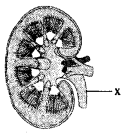
A) Cortex
B) Medulla
C) Nephron
D) Ureter
Answer:
D) Ureter
![]()
Question 154.
In Latin ‘excretion’ means [ ]
A) in
B) out
C) shift
D) none
Answer:
B) out
Question 155.
In humans secretion materials are [ ]
A) Enzymes
B) Hormones
C) Saliva
D) All the above
Answer:
D) All the above
Question 156.
A pair of whitish, narrow distensible and muscular tubes of kidneys are [ ]
A) Ureters
B) Nephron
C) DCT
D) PCT
Answer:
A) Ureters
Question 157.
Complete this table. [ ]
| Plant | Product |
| 1) Pinus 2) Cassia |
? Tannins |
A) Gum
B) Alkaloid
C) Latex
D) Resin
Answer:
D) Resin
Question 158.
Complete this table.
| Plant | Product |
| 1) Revea brazi lences 2) Jatropa |
? Bio- Diesel |
A) Resins
C) Medicines
B) Paints
D) Rubber
Answer:
D) Rubber
Question 159.
Complete this flow chart. [ ]

A) Bk
B) Seeds
C) Leaves
D) All the above
Answer:
D) All the above
![]()
Question 160.
Scopa lamine; Datura, Pyrethroids:
A) Azadirachta
B) Coffea
C) Rauwolfia
D) Chrysanthemum
Answer:
D) Chrysanthemum
Question 161.
Complete the table with the correct answer.
| Organism | Excretory organ |
| 1) Revea brazi lences 2) Jatropa |
? flame cells |
A) Meta nephreclia
B) Maiphigian tubules
C) Canal system
D) Nephredia
Answer:
………….
Question 162.
Match the following.
List-A —- List-B
1) Canal system ( ) (a) Starfish
2) Water vascular system — (b) Amoeba
3) Diffusion — (c) Sponges
A) 1 – a, 2 – b, 3 – c
B) 1 – b, 2 – a, 3 – c
C) 1 – c, 2 – b, 3 – a
D) 1 – c, 2 – a, 3 – b
Answer:
D) 1 – c, 2 – a, 3 – b
Question 163.
Identify the mis-matched pair. [ ]
1) Human beings — Urea
2) Fish — Uric acid
3) Birds — Ammonia
A) 1 only
B) 1,2
C) 3only
D) 2,3
Answer:
D) 2,3
Question 164.
Identify the mismatched pair. [ ]
1) Datura — Antiseptic
2) Tobacco — Carcinogenic agent
3) Coffee — CNS Stimulant
A) 2,3
B) 3 only
C) 2 only
D) 1 only
Answer:
D) 1 only
![]()
Question 165.
Reserpine : Root, Quinine: ……. [ ]
A) Leaves
B) Seeds
C) Bark
D) Flower
Answer:
C) Bark
Question 166.
Caffeine : Seed, Scoplamine:…….?
A) Leaf
B) Fruit
C) Flower
D) B and C
Answer:
D) B and C
Question 167.
Morphine and Cocaine are extracted from this plant [ ]
A) Rauwolfia
B) Coffea
C) Datura
D) Papayer
Answer:
D) Papayer
Question 168.
Match the following. [ ]
List-A —- List-B
1) Anti malarial ( ) a) Nicotine drug
2) Insecticide ( ) b) Reserpine
3) Medicine for ( ) c) Quinine snake bite
A) 1-a, 2-b, 3-c
B) 1-c, 2-b, 3-a
C) 1-b, 2-c, 3-a
D) 1-c, 2-a, 3-b
Answer:
D) 1-c, 2-a, 3-b
![]()
Question 169.
Can you identify this alkaloid plant?
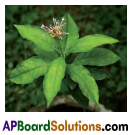
A) Papayer
B) Neem
C) Datura
D) Rauwolfia
Answer:
D) Rauwolfia
Question 170.
Can you identify this resin yielding plant?

A) Acacia
B) Cassia
C) Neem
D) Pinus
Answer:
D) Pinus
Question 171.
Can you identify this tannin giving plant?
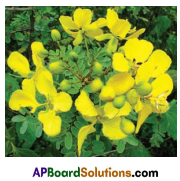
A) Cassia
B) Acacia
C) Pinus
D) Jatropa
Answer:
A) Cassia
Question 172.
This plant has high commercial value. Can you identify this plant?
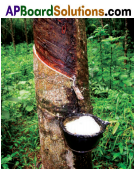 T
T
A) Neem
B) Papayer
C) Datura
D) Hevea
Answer:
D) Hevea
Question 173.
From the above plant we get [ ]

A) Tannins
B) Resins
C) Alkaloid
D) Bio-diesel
Answer:
D) Bio-diesel
![]()
Question 174.
Plants secret gums to …… [ ]
A) to stick the insects
B) to excrete wastes
C) to expel the alkaloids
D) to heal the damaged parts of the plants
Answer:
D) to heal the damaged parts of the plants
Question 175.
Resins :………… ; Gums : Adhesives
A) Tannins
B) Medicines
C) Ropes
D) Varnish
Answer:
D) Varnish
Question 176.
These are deep brown coloured Carbon compounds. which are commercially very useful [ ]
A) Resins
B) Gums
C) Tannins
D) Alkaloids
Answer:
C) Tannins
Question 177.
Match the following. [ ]
List-A List-B
1) Chicle ( ) a) Allergens
2) Parthenium ( ) b) Gums
3) Neern ( ) c) Chewing gum
A) 1 – a, 2 – b, 3 – c
B) 1 – c, 2 – b, 3 – a
C) 1 – c, 2 – a. 3 – b
D) 1 – b, 2 – a, 3 – c
Answer:
C) 1 – c, 2 – a. 3 – b
Question 178.
The person in the given picture is undergoing a process. Can you name the process? [ ]
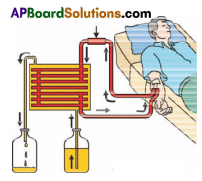
A) peritonial dialysis
B) blood transfusion
C) 2-D- Echo
D) haemo dialysis
Answer:
D) haemo dialysis
![]()
Question 179.
In this figure ‘X’ denotes
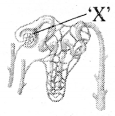
A) PCT
B) DCT
C) Henle’s loop
D) Glornerulus
Answer:
D) Glornerulus
Question 180.
Tubular reabsorption takes place here. [ ]
A) Glornerulus
B) DCT
C) Henle’s loop
D) PCT
Answer:
D) PCT
Question 181.
In the figure ‘X’ denoted zone, this process takes place. [ ]

A) ultra filtration
B) tubular reabsorption
C) tubular secretion
D) concentration of urine
Answer:
C) tubular secretion
![]()
Question 182.
Concentrated urine is passed out because of the secretion of this hormone [ ]
A) Thyroxine
B) Vasopressin
C) Insulin
D) Pituitary
Answer:
B) Vasopressin
Question 183.
In this figure, X denotes………….
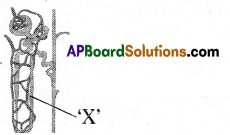
A) Collecting duct
B) First convoluted tubule
C) Capillary network
D) Loop of Henle
Answer:
D) Loop of Henle
Question 184.
In this figure ‘X’ denotes ………….
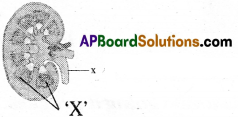
A) Cortex
B) Medulla
C) Nephron
D) Calyces
Answer:
D) Calyces
Question 185.
In this figure ‘X’denotes [ ]
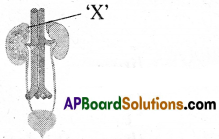
A) Ureter
B) Venacava
C) Dorsal aorta
D) Adrenal gland
Answer:
D) Adrenal gland
Question 186.
Annelida : Nephredia, Mollusca :
A) Kidneys
B) Flame cells
C) Green glands
D) Meta Nephredia
Answer:
D) Meta Nephredia
![]()
Question 187.
Sponges: Canal system, Starfish:
A) Diffusion
B) Flame cells
C) Meta Nephredia
D) Water vascular system
Answer:
D) Water vascular system
Question 188.
Cockroach : Malpigliian tubules, Snail: …….
A) Green glands
B) Flame cells
C) Nephredia
D) Meta nephredia
Answer:
D) Meta nephredia
Question 189.
Earthworm : Nephredia, Plana ria: ………………?
A) Meta nephredia
B) Green glands
C) Flame cells
D) Canal system
Answer:
C) Flame cells